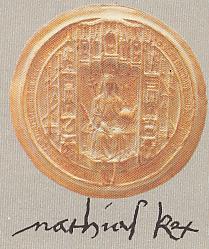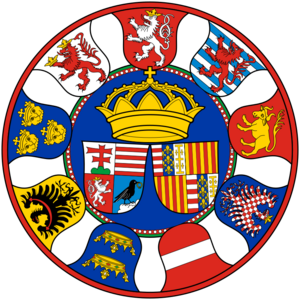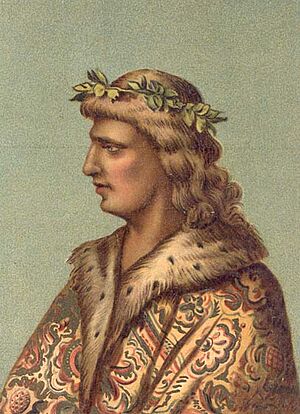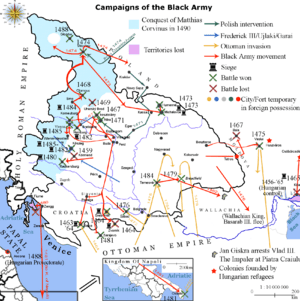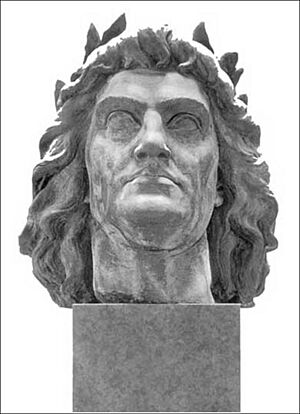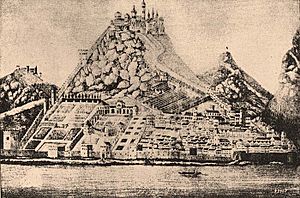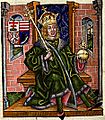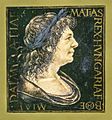Matthias Corvinus facts for kids
Quick facts for kids Matthias Corvinus |
|
|---|---|
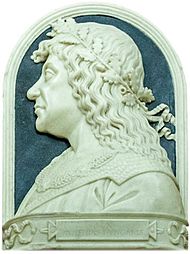 |
|
| King of Hungary and Croatia | |
| Reign | 1458–1490 |
| Coronation | 29 April 1464 |
| Predecessor | Ladislaus V |
| Successor | Vladislaus II |
| Regent | Michael Szilágyi (1458) |
| King of Bohemia contested by George and Vladislaus II |
|
| Reign | 1469–1490 |
| Predecessor | George |
| Successor | Vladislaus II |
| Duke of Austria contested by Frederick V |
|
| Reign | 1487–1490 |
| Predecessor | Frederick V |
| Successor | Frederick V |
| Born | 23 February 1443 Kolozsvár, Hungary (now Cluj-Napoca, Romania) |
| Died | 6 April 1490 (aged 47) Vienna, Austria |
| Burial | Royal Basilica, Székesfehérvár |
| Spouse | Elizabeth of Celje Catherine of Poděbrady Beatrice of Naples |
| Issue | John Corvinus |
| House | Hunyadi |
| Father | John Hunyadi |
| Mother | Elizabeth Szilágyi |
| Religion | Roman Catholic |
| Signature | |
Matthias Corvinus (born February 23, 1443 – died April 6, 1490) was a very important king. People sometimes called him the Just in old stories. He became King of Hungary and Croatia in 1458 when he was only 14 years old. He ruled until he died.
Matthias was also a powerful military leader. He won many battles and became King of Bohemia (from 1469 to 1490) and Duke of Austria (from 1486 to 1490). During his time, Hungary was the first European country to embrace the Renaissance ideas from Italy.
As a Renaissance ruler, Matthias loved learning and art. He started new schools and supported artists and scientists. He also created a new legal system for the Kingdom of Hungary. Matthias tried to rule like a "philosopher-king," an idea from the ancient Greek thinker Plato.
Contents
Other Names for Matthias
Matthias Corvinus was known by different names in various languages:
- Medieval Latin: Mattias Corvinus
- Romanian: Matia/Matei/Mateiaş Corvin/Corvinul
- Croatian: Matija/Matijaš Korvin
- Czech: Matyáš Korvín
- German: Matthias Corvinus
- Polish: Maciej Korwin
- Rusyn: Матяш Корвiн/Matiash Corvin
- Serbian: Матија Корвин/Matija Korvin
- Slovak: Matej Korvín
- Hungarian: Hunyadi Mátyás or Corvin Mátyás
- Slovene: Matija Korvin
- Russian: Матьяш Корвин/Matyash Korvin
Matthias's Early Life

Matthias was born in Kolozsvár, which is now Cluj-Napoca, Romania. His home is now called the Matthias Corvinus House. He was the second son of John Hunyadi, a very successful general in Hungary. John Hunyadi had become a powerful leader and even a regent (a temporary ruler) of Hungary.
Matthias's mother was Erzsébet Szilágyi, who came from an important Hungarian noble family. Matthias had excellent teachers, including János Vitéz, a bishop. He also learned from the Polish scholar Gregory of Sanok.
Besides learning many languages, Matthias also trained as a soldier. He started following his father on military campaigns when he was just twelve. In 1456, he was knighted at the famous Siege of Belgrade.
Matthias's Rule as King
Becoming King
Matthias was the first Hungarian king from a noble family, not a royal one. This was a big change for the country. He became king at a difficult time. Hungary was threatened by the Ottomans from the south. Emperor Frederick III and Casimir IV of Poland also wanted the Hungarian throne.
Matthias was only 15 when he became king. He quickly showed he was a strong leader. He removed powerful nobles who opposed him. He also started collecting taxes to hire soldiers. This helped him create a strong central government.
He fought against the Ottomans and took back the Golubac Fortress. He also gained control over parts of Bosnia. In 1461, he married Catherine, the daughter of George of Poděbrady, who was the King of Bohemia.
In 1462, Matthias made a deal with Emperor Frederick. Frederick returned the holy crown of Hungary to Matthias. This deal helped Matthias become the recognized ruler of Hungary. He then focused on fighting the Ottomans again. He captured the fortress of Jajce in Bosnia in 1463. Matthias was officially crowned King of Hungary in 1464. Sadly, his wife Catherine died shortly after.
Wars in Central Europe
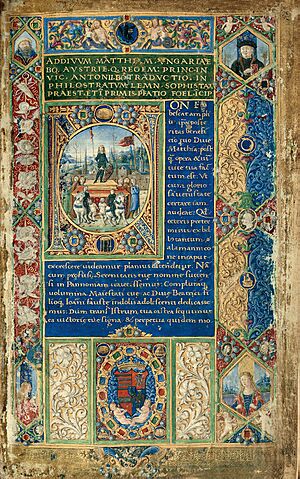
Matthias made his power stronger by creating a large royal army. This army was called the fekete sereg or the King's Black Army. It was made up of professional mercenary soldiers. With this army, Hungary became very large and powerful. It stretched from present-day Germany to Poland and down to Dalmatia.
Matthias also fought against George of Poděbrady in Bohemia. In 1469, the Bohemian Catholics chose Matthias as their king. However, George made a deal with Poland, which complicated things. After George died, Matthias faced a rebellion in Hungary. He put down the rebellion and then fought against the Poles. They made peace in 1475.
Matthias also fought against Emperor Frederick again. He won and forced Frederick to make peace. Matthias gained control of Moravia, Silesia, and parts of Lusatia. The emperor also promised to pay Matthias a lot of money. In 1476, Matthias married his third wife, Beatrice, daughter of the King of Naples.
When Frederick didn't keep his promises, Matthias attacked him again in 1481. On June 1, 1485, Matthias marched into Vienna and made it his new capital. He also took control of Styria, Carinthia, and Carniola. Matthias became the most powerful ruler in central Europe.
Wars Against the Ottoman Empire
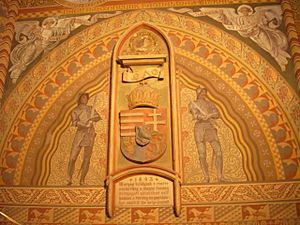
Matthias also focused on protecting his borders from the Ottoman Empire. In 1471, he helped create the Serbian Despotate in southern Hungary. In 1479, a large Ottoman army was defeated in the Battle of Breadfield. The next year, Matthias took back Jajce and other areas from the Ottomans.
In 1480, when the Ottomans captured Otranto in Italy, Matthias sent his general, Balázs Magyar, to help. They successfully took back the fortress. Matthias also helped protect Ancona with Hungarian soldiers.
After the Ottoman Sultan Mehmet II died in 1481, there was a fight for power between his sons. Matthias tried to use this to his advantage, but other European powers didn't agree. Matthias spent his last days trying to make his illegitimate son, John Corvinus, his successor. However, his wife Beatrice was against it. Matthias died suddenly on April 6, 1490.
Relations with Wallachia and Moldavia
Matthias sometimes worked with Vlad III the Impaler, the Prince of Wallachia. Vlad was known for fighting bravely against the Ottomans. However, Matthias and Vlad had disagreements, and Matthias even imprisoned Vlad for a while. Later, Vlad was freed and married Matthias's cousin. He was sent to fight the Ottomans in Wallachia with Hungarian support, but he was killed in 1476.
In 1467, Matthias had a conflict with Stephen III, the Prince of Moldavia. Stephen was tired of Hungarian influence in Wallachia. This led to a battle where Matthias suffered a defeat.
Matthias's Support for Arts and Learning
Matthias loved Italian culture and the Italian Renaissance. He brought many Italian artists and scholars to Hungary. Cities like Buda, Esztergom, Székesfehérvár, and Visegrád benefited from his support. He built new health and education centers and improved the legal system.
In 1465, he founded a university in Bratislava, called the Universitas Istropolitana. This was the third university in medieval Hungary. His marriage to Beatrice of Naples in 1476 further increased Italian influence.
Matthias rebuilt the Royal residence of Buda in the new Renaissance style. His summer palace at Visegrád was also beautiful. Many famous Italian scholars and artists worked at his court, including Antonio Bonfini and Leonardo da Vinci. Leonardo even painted a Madonna for Matthias.
Matthias also supported scientists. The famous mapmaker Francesco Rosselli created detailed maps for him. The astronomer Johannes Regiomontanus built special instruments for the king. Matthias was interested in philosophy and often discussed ideas with scholars.
The Royal Library
Matthias Corvinus had one of the greatest collections of books in Europe. His library, called the Bibliotheca Corviniana, had many historical, philosophical, and scientific works. It was the second largest library in Europe, only smaller than the Vatican Library. Matthias loved reading and would often spend half his nights reading after a busy day.
Matthias's Legacy
Matthias was a skilled diplomat. He had strong relationships with his neighbors, the Pope, and the Kingdom of Naples. He also connected with France, Switzerland, and many German states.
After Matthias died, his empire fell apart. He had no legitimate children, only an illegitimate son, John Corvinus. The Hungarian nobles did not accept John as king. Instead, Ladislaus II of the Jagiellon family became king.
Matthias's rule had high taxes, especially for peasants. These taxes paid for his lavish lifestyle and his Black Army. After his death, the Black Army caused problems. However, Matthias is still seen as one of Hungary's greatest rulers. He was elected king by the people, kept the powerful nobles in check, and was known for his fairness.
People still call him Matthias the Just (Mátyás, az igazságos in Hungarian). He is a popular hero in Hungarian folk tales. There's a Hungarian saying: Matthias has died, justice is gone. He is also known as King Matjaž in Slovenia, a "sleeping king" who will return one day.
In Romania, people also remember Matthias and his father for their bravery and cultural achievements.
Matthias's Titles
In 1486, Matthias's official titles included:
- King of Hungary, Bohemia, Dalmatia, Croatia, Rama, Serbia, Lodomeria, Cumania, and Bulgaria
- Prince of Silesia and Luxembourg
- Margrave of Moravia and Lusatia
Gallery
-
Matthias as a figure of Romance: The Mátyás Fountain, Budapest (Alajos Stróbl, 1902)
-
Mátyás Hunyadi memorial coin (Coins of the Hungarian forint, by László Szlávics, Jr., 2008)
-
Matthias on the 1000 Hungarian forint banknote
Images for kids
-
The house where Matthias Corvinus was born in Kolozsvár (present-day Cluj-Napoca, Romania)
-
Matthias's golden florin depicting Madonna and Child, and King Saint Ladislaus
-
Renaissance portrait of Matthias Corvinus, King of Hungary, (marble relief by Giovanni Dalmata (attributed to), Benedetto da Maiano (previous attribution) 1476)
-
This stove tile depicts King Matthias (from Buda Castle, 1480)
See also
 In Spanish: Matías Corvino para niños
In Spanish: Matías Corvino para niños


